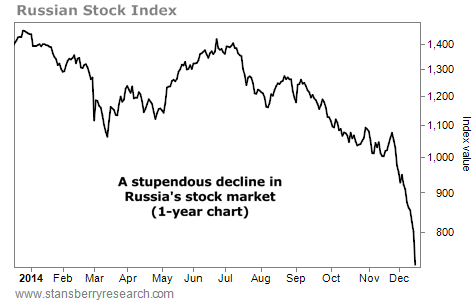| Home | About Us | Resources | Archive | Free Reports | Market Window |
Your Biggest Chance for Capital Gains in 2015By
Wednesday, December 17, 2014
"For me, it was my mother."
That's what Street Smarts author and investor Jim Rogers said during the annual Stansberry Alliance Conference in the Dominican Republic last month.
Stansberry Research founder Porter Stansberry had just asked Jim if he knew anyone whose opinion he valued as a contrary indicator.
Jim said his mom would call, wanting to buy shares of some company. Rogers would say, "But Mother, why do you want to buy that stock? It has already tripled! You're supposed to buy before they triple, not after."
If his mom called, he knew whatever stock she was interested in was a bad investment idea…
I've heard many stories like that. My colleague Jeff Clark writes about his mother doing the same thing. He calls it "The Mother Indicator."
I bet every investment or finance professional has a relative who gets excited about buying stocks after they've gone up a bunch... and depressed about owning them after they've gone down a bunch.
Most people are like Jim's late mother. They follow the crowd.
They only feel comfortable buying when prices are high. But a good contrarian knows that's when they should sell, or at least refrain from buying. Most folks feel like selling when prices are low. But that's when good contrarians are buying.
That's the bottom line on why most people lose money in stocks.
To reverse this dangerous cycle and start making money instead of losing it, investors should embrace The Principle of Ever-Changing Cycles.
That's the title of Chapter 5 of Robert L. Bacon's classic book on betting the ponies, Secrets of Professional Turf Betting.
On page 31, Bacon writes...
The principle of ever-changing cycles turns bull markets to bear markets and vice versa. In both cases, the public embraces a trend, and the embrace becomes the kiss of death. The trend reverses and leaves the majority of investors holding losses or missing out on new bull-market gains. Technology stocks were a winning idea in the late 1990s... until the tech-heavy Nasdaq peaked in March 2000 and changed suddenly and drastically, falling 78.5% over the next two and a half years. Housing and structured finance were winning ideas until they suddenly and drastically caused the biggest financial crisis since the Great Depression.
The principle of ever-changing cycles works at the bottom, too. Everyone hated stocks in March 2009, the perfect moment to buy. Stocks suddenly and drastically soared that year and for the next four years.
Natural resource stocks were adored in spring 2011. Investors got used to winning back some of the money they lost in the financial crisis. They read stories about the Federal Reserve printing record amounts of money to stimulate the economy. They feared inflation.
Gold hit a new all-time high of $1,900 an ounce. Gold and resource stocks were rising and the trend attracted investors who'd lost money in the 2008-2009 crash. The public had gotten wise to a winning idea. Then a quick and drastic change drove the U.S. dollar up and commodity prices and mining stocks down, down, down.
The sequence of results in metals prices has been extremely bad for the past three years, driving down precious-metal and base-metal prices. Here's what things look like today...
A sudden and drastic reversal of the bearish trend at this point would surprise everyone... except those of us who know how the principle of ever-changing cycles forces quick and drastic changes right when the expectation of more of the same becomes a popular idea. And of course, the share prices of the companies that produce these metals have been hit even harder. The Market Vectors Gold Miners Fund (GDX) is down about 73% in the last three and a half years. The Market Vectors Junior Gold Miners Fund (GDXJ) is even worse, down 85%. The numbers boggle the mind.
The losses suffered by so many investors in natural resources over the past three years won't go on forever. Once the public "gets wise" and expects an existing trend to continue – either bullish or bearish – a quick and drastic change usually isn't too far away.
I expect that to happen in natural resource stocks – a quick and drastic change... a reversal of the bear market.
I'm not a wizard. I can't predict exactly when a quick and drastic change will turn the resource bear market into a bull. But I suspect it'll happen soon.
When it does, you could make a ton of money in the upswing. In tomorrow's essay, I'll share why I think this quick and drastic change to the upside in natural resource stocks will happen sooner than most people think… And how it may be your best chance to make 10 times your money in stocks over the next few years.
Good investing,
Dan Ferris
Further Reading:
"When it comes to natural resource investments, you're either a contrarian or a victim," Dan writes. "And victims are selling today." Ride out the panicky downtrends, Dan says, and you could make a fortune in resource stocks over the next few years. Learn more here.
Matt Badiali says despite the selloff in most natural resources, one has been quietly soaring. Learn why he says this could be "the trade of 2015" right here.
Market NotesA STUPENDOUS DECLINE IN RUSSIA'S STOCK MARKET Remember today's chart. It shows something you might not see again for years...
Right now, Russia is having severe economic trouble. Its economy is highly dependent on oil for revenue. Since oil prices have dropped from $110 per barrel to $63 since the summer, Russia's economy, its currency, and its stock market are suffering.
Today's chart shows that in Russia's stock market, the suffering is incredible. The benchmark Russian stock index has fallen a stunning 42% in the past four months. Its price action resembles the trajectory of a cliff diver.
To put this dive into context, realize that if a country's stock index falls 10% in four months, experienced investors consider it a big decline. If a country's index falls 25% in four months, it's considered a huge decline. Russia's index has fallen a stupendous 42% in four months. This is a move you rarely see in the market... a move four times more severe than "big." It shows Russia is a country in crisis.
 |
Recent Articles
|



